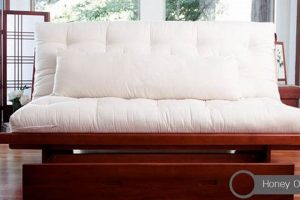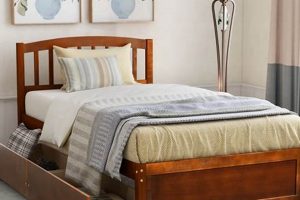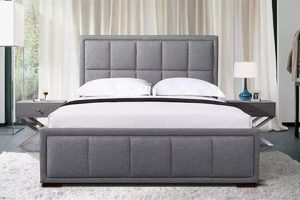A structure designed to support both a box spring and a mattress elevates the sleeping surface, providing a stable and aesthetically pleasing foundation within a bedroom. These frames come in diverse materials, including wood, metal, and upholstered options, each offering varying degrees of support, style, and durability. A platform designed for this specific dual purpose differs from those intended only for a mattress alone, ensuring compatibility and optimal sleep quality.
Employing a supporting structure for a box spring and mattress offers several advantages, encompassing improved mattress longevity through even weight distribution and preventing sagging. The elevated height facilitates easier access and egress, particularly beneficial for individuals with mobility challenges. Historically, these structures evolved from simple wooden platforms to more elaborate designs incorporating headboards, footboards, and decorative elements, reflecting changes in interior design and comfort preferences.
Understanding the variety of designs, materials, and construction methods is crucial when selecting a suitable support system. Further discussion will explore the different frame types, their associated benefits, and considerations for choosing the ideal option based on individual needs and preferences, ensuring a well-supported and comfortable sleep environment.
Selecting a Supportive Structure
Choosing the appropriate supporting structure for a box spring and mattress involves careful evaluation of several factors to ensure long-term comfort and durability.
Tip 1: Material Selection: Opt for materials known for their structural integrity. Solid wood and heavy-gauge steel offer superior support compared to lightweight or composite materials.
Tip 2: Weight Capacity Assessment: Verify the frame’s weight capacity to ensure it can adequately support the combined weight of the box spring, mattress, and occupants. Exceeding the weight limit can lead to premature failure.
Tip 3: Slat Spacing Evaluation: If the design incorporates slats, ensure the spacing between slats is minimal. Excessive spacing can cause the mattress to sag and compromise support.
Tip 4: Center Support Examination: For larger sizes, such as queen and king, prioritize designs with a center support beam and additional legs. This provides crucial reinforcement and prevents bowing.
Tip 5: Headboard/Footboard Compatibility Verification: If intending to attach a headboard or footboard, confirm that the frame is compatible with standard attachment methods. Incompatible connections can lead to instability.
Tip 6: Assembly Complexity Consideration: Evaluate the assembly process before purchase. Complex assemblies may require professional assistance, adding to the overall cost.
Tip 7: Clearance Assessment: Determine the desired under-bed clearance for storage purposes. Consider the height of storage containers and ensure sufficient space is available.
Adhering to these guidelines ensures the selection of a robust and appropriate supporting structure for a box spring and mattress, promoting longevity, comfort, and restful sleep.
With a firmer grasp of essential considerations, the subsequent sections will delve into specific frame styles and their individual attributes.
1. Support and Stability
The structural integrity of a foundation for a box spring and mattress directly impacts the quality of sleep and the lifespan of the bedding. Adequate support prevents sagging, minimizes motion transfer, and ensures proper spinal alignment. A stable structure reduces noise and the potential for structural failure.
- Material Composition and Construction
The materials used in the frame’s construction, such as solid wood, steel, or reinforced composites, dictate its ability to withstand weight and resist deformation. Robust construction techniques, including reinforced joints and crossbeams, enhance stability. A poorly constructed frame, regardless of material, is susceptible to bending or breaking under load, compromising support.
- Slat Design and Distribution
Frames utilizing slats require careful consideration of slat material, width, thickness, and spacing. Slats that are too thin or spaced too far apart will not provide sufficient support, leading to mattress sagging. The quantity and distribution of slats across the frame’s surface are critical for evenly distributing weight and preventing localized pressure points.
- Leg Support and Placement
The number, type, and placement of legs influence the frame’s stability, particularly for larger sizes. Insufficient leg support, especially in the center of the frame, can result in bowing and instability. Wide, sturdy legs with non-slip feet contribute to a stable and level platform, minimizing movement and noise.
- Joint Integrity and Fasteners
The connections between frame components must be robust and secure. Weak or poorly designed joints are prone to loosening or failure over time, compromising the overall stability of the structure. High-quality fasteners, such as bolts and screws, combined with appropriate adhesives, ensure long-term joint integrity.
These interconnected factors collectively determine the ability of a foundation for a box spring and mattress to provide adequate support and maintain stability over time. Investing in a well-constructed frame with attention to material, design, and construction detail is crucial for maximizing comfort, minimizing wear and tear on the bedding, and ensuring a restful sleep experience.
2. Size Compatibility
The dimensional harmony between a supporting structure and its intended box spring and mattress is a critical determinant of both sleep quality and furniture longevity. Incompatibility manifests as inadequate support, premature wear, and potential safety hazards. A frame designed for a full-sized bed, for instance, cannot properly accommodate a queen-sized mattress and box spring. The resulting overhang or instability compromises the intended weight distribution, leading to mattress sagging and reduced lifespan. Conversely, a frame significantly larger than the bedding unit permits excessive movement, creating noise and disrupting sleep.
The practical significance of accurate size matching extends beyond mere aesthetics. Consider the case of a California King mattress placed on a standard King frame: the insufficient length results in unsupported areas, typically at the head or foot of the bed, accelerating wear and creating an uneven sleep surface. Retailers often provide detailed size specifications for both frames and bedding to mitigate these issues. Compliance with these specifications, verified through precise measurements, is essential for ensuring a secure and stable foundation. Moreover, the selection of appropriate linens and bedding accessories hinges on the dimensional accuracy of the supporting structure.
In conclusion, the relationship between frame size and bedding dimensions is a non-negotiable aspect of bed frame selection. Failure to adhere to recommended size pairings precipitates structural instability, diminishes sleep quality, and shortens the lifespan of the mattress and box spring. Diligent measurement and careful consideration of manufacturer specifications are paramount for optimizing the functionality and longevity of this essential bedroom furnishing.
3. Material Durability
Material durability constitutes a fundamental consideration in the selection of a supporting structure for a box spring and mattress. The ability of the frame’s constituent materials to withstand sustained weight, resist environmental degradation, and maintain structural integrity over an extended period directly influences its lifespan and the comfort provided. The choice of material dictates the frame’s resistance to common stressors such as impacts, moisture, and cyclical loading, thereby impacting its long-term performance.
- Wood Species and Treatment
The specific wood species utilized, coupled with its treatment, significantly affects the frame’s durability. Hardwoods such as oak, maple, and mahogany offer superior strength and resistance to wear compared to softwoods like pine. Furthermore, proper treatment, including kiln-drying to reduce moisture content and the application of protective coatings, mitigates warping, cracking, and insect infestation. Untreated or improperly treated wood is susceptible to degradation, compromising the frame’s structural integrity over time. An example would be using pressure treated lumber to protect against termites, and decay from fungi.
- Metal Gauge and Finish
For metal frames, the gauge (thickness) of the steel and the type of finish applied are critical determinants of durability. Higher gauge steel provides greater resistance to bending and deformation under load. Powder-coated finishes offer superior corrosion protection compared to painted finishes, preventing rust and maintaining the frame’s aesthetic appearance. Thin gauge steel or inadequate finishing can lead to structural weaknesses and premature failure, especially in humid environments.
- Joint Construction and Hardware
The manner in which frame components are joined and the quality of the hardware used contribute significantly to its overall durability. Reinforced joints, employing techniques such as mortise-and-tenon or welding, provide greater strength and resistance to stress compared to simple screw connections. High-quality hardware, including bolts, screws, and brackets, ensures secure and lasting connections. Weak joints or substandard hardware can compromise the frame’s structural integrity and lead to instability.
- Upholstery Fabrics and Stitching (If Applicable)
For upholstered frames, the durability of the fabric and the quality of the stitching are important considerations. Durable fabrics, such as linen, or high-performance synthetics, resist tearing, staining, and fading. Tight, even stitching prevents seam unraveling and maintains the fabric’s integrity over time. Flimsy fabrics or poorly executed stitching can detract from the frame’s appearance and shorten its lifespan.
In summary, material durability is an indispensable attribute of a robust supporting structure. The selection of appropriate materials, combined with sound construction techniques, ensures the frame’s ability to withstand the rigors of daily use and maintain its structural integrity over an extended period. Careful consideration of these factors is crucial for optimizing the value and longevity of any supporting structure for a box spring and mattress.
4. Style Integration
The successful integration of a bed frame’s aesthetic with the existing decor is a critical aspect of bedroom design. The frame serves as a focal point, influencing the overall ambiance and reflecting the homeowner’s personal style. Achieving harmonious style integration necessitates careful consideration of design elements, material choices, and color palettes.
- Architectural Harmony
The frame’s style should complement the architectural characteristics of the room. A minimalist metal frame aligns well with contemporary spaces, while a carved wooden frame suits traditional or rustic environments. Mismatched styles can create visual discord and detract from the room’s overall aesthetic appeal. For instance, a ornate Victorian style headboard would likely look out of place in a modern loft apartment.
- Material Coordination
The materials comprising the frame should coordinate with other elements in the room, such as flooring, furniture, and textiles. A wooden frame can echo the wood tones in a dresser or nightstand, while a metal frame can complement metallic accents in lighting fixtures or hardware. Contrasting materials, when used deliberately, can create visual interest, but require careful consideration to avoid clashing. For example, if a room contains black metal lighting fixtures a black metal bedframe would be a good choice.
- Color Palette Alignment
The frame’s color should align with the room’s overall color palette. Neutral colors, such as white, gray, or black, offer versatility and blend seamlessly with various decor styles. Bold colors can create a statement, but should be chosen carefully to complement existing hues and avoid overwhelming the space. A dark wood bedframe would pair well with earth tone palettes.
- Headboard and Footboard Design
The design of the headboard and footboard significantly impacts the frame’s style. Simple, geometric designs align with modern aesthetics, while elaborate carvings or tufted upholstery suit more traditional tastes. The size and shape of the headboard can also influence the perceived scale of the room. A tall headboard will make the room seem smaller.
Achieving successful style integration involves a holistic approach that considers all elements of the bedroom’s design. By carefully coordinating the frame’s style, materials, color, and design elements, one can create a cohesive and visually appealing space that reflects the homeowner’s personal taste and enhances the overall ambiance of the room, ensuring the entire bedroom is appealing.
5. Height Considerations
The height of a support structure for a box spring and mattress is a critical design element that influences both accessibility and overall comfort. The distance from the floor to the top of the mattress directly impacts ease of entry and exit, particularly for individuals with mobility limitations. A frame that positions the sleeping surface too low can exacerbate joint pain and increase the risk of falls. Conversely, an excessively high frame may necessitate the use of a step stool, posing similar accessibility challenges. The ideal height typically ranges between 20 and 25 inches, accommodating a standard mattress and box spring while providing a comfortable transition for most adults. For instance, elderly individuals or those recovering from surgery often benefit from higher frames that minimize strain during movement.
Beyond accessibility, height influences under-bed storage capacity and the perceived spatial dimensions of the room. A taller frame provides ample room for storing bins or other items, maximizing available space in smaller living areas. This is particularly relevant in urban apartments or homes with limited closet space. However, an excessively high frame can visually compress the room, creating a sense of confinement. The selection of an appropriate frame height should therefore consider both functional storage needs and the overall aesthetic impact on the surrounding environment. The availability of adjustable-height frames offers a practical solution for accommodating diverse needs and preferences.
Ultimately, height considerations represent a crucial facet of frame selection, impacting accessibility, storage capacity, and spatial perception. Neglecting this aspect can lead to discomfort, inconvenience, and aesthetic compromises. By carefully evaluating individual needs and preferences, and by consulting height guidelines, it is possible to select a frame that optimizes both functionality and comfort, contributing to an enhanced sleep experience and a more harmonious living environment. The integration of adjustable features further enhances the adaptability and long-term value of this essential furniture component.
Frequently Asked Questions
The following questions address common concerns and misconceptions regarding the selection, use, and maintenance of bed frames designed for box springs and mattresses.
Question 1: What differentiates a frame designed for a box spring and mattress from a platform bed frame?
A frame for a box spring and mattress is specifically engineered to support both components. Platform bed frames, conversely, are designed to support a mattress directly, often eliminating the need for a box spring. The support structure, slat spacing, and overall height differ significantly between these two types.
Question 2: What are the potential consequences of using an improperly sized frame?
Using a frame that is too small can result in inadequate support, causing the mattress to sag prematurely. A frame that is too large can lead to instability and excessive movement of the bedding, compromising sleep quality. Dimensional compatibility is critical for optimal performance.
Question 3: How does the material composition of the frame impact its longevity?
Frames constructed from durable materials such as solid wood or heavy-gauge steel generally offer greater resistance to wear and tear compared to those made from lightweight or composite materials. The material’s ability to withstand weight and resist environmental degradation directly affects the frame’s lifespan.
Question 4: Is assembly required for most frames designed for box springs and mattresses?
Assembly requirements vary depending on the specific model and manufacturer. Some frames arrive fully assembled, while others require partial or complete assembly. Evaluating the complexity of the assembly process prior to purchase is advisable.
Question 5: How does the height of the frame influence comfort and accessibility?
The frame’s height directly impacts ease of entry and exit from the bed. A height that is too low can strain joints, while a height that is too high may necessitate the use of a step stool. The ideal height should be determined based on individual needs and preferences.
Question 6: What maintenance practices are recommended to prolong the lifespan of a bed frame?
Regularly tightening bolts and screws, cleaning the frame with appropriate cleaning agents, and avoiding excessive weight loads can help prolong its lifespan. Inspecting the frame periodically for signs of damage or wear is also recommended.
These frequently asked questions underscore the importance of careful consideration when selecting and maintaining a support structure for a box spring and mattress. Proper attention to these details ensures optimal comfort, longevity, and value.
The subsequent section will explore the various styles and designs available in the marketplace.
Concluding Summary
This discourse has examined the bed frame for box spring and mattress, addressing critical considerations for selection and long-term utility. Structural integrity, dimensional compatibility, material durability, stylistic integration, and height optimization represent key factors influencing both sleep quality and furniture longevity. Careful evaluation of these aspects ensures informed decision-making.
The selection of an appropriate bed frame necessitates a comprehensive understanding of individual needs and available options. Prioritizing durability, stability, and aesthetic harmony will contribute to a supportive and comfortable sleep environment, ultimately enhancing overall well-being. Continued awareness of evolving designs and materials will further inform future purchase decisions within this essential furniture category.



![Best Floor Mattress Frame [Guide & Reviews] Organic & Natural Mattress Buyer’s Guide: Non-Toxic Sleep Solutions Best Floor Mattress Frame [Guide & Reviews] | Organic & Natural Mattress Buyer’s Guide: Non-Toxic Sleep Solutions](https://mattressworldpa.com/wp-content/uploads/2025/07/th-3054-300x200.jpg)

![Best Queen Size Mattress & Frame: [Sleep Soundly] Organic & Natural Mattress Buyer’s Guide: Non-Toxic Sleep Solutions Best Queen Size Mattress & Frame: [Sleep Soundly] | Organic & Natural Mattress Buyer’s Guide: Non-Toxic Sleep Solutions](https://mattressworldpa.com/wp-content/uploads/2025/07/th-3052-300x200.jpg)

